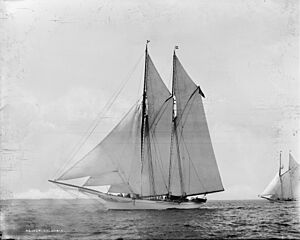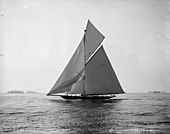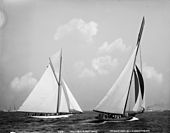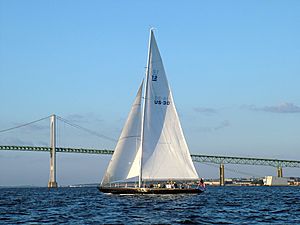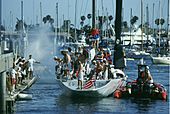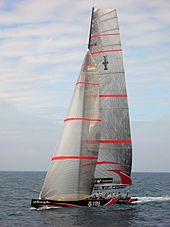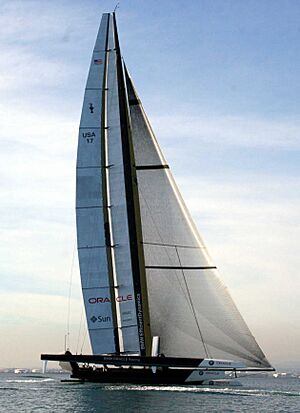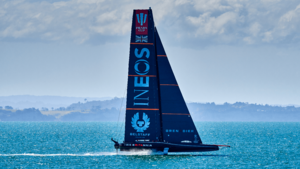History of the America's Cup facts for kids
The America's Cup is the oldest international sports competition still happening today. It's like the Super Bowl or World Cup of sailing!
This famous trophy was first called the 'R.Y.S. £100 Cup'. It was first given out in 1851 by the British Royal Yacht Squadron. The race was held around the Isle of Wight in the United Kingdom. The winning boat was a schooner named America. It was owned by a group from the New York Yacht Club (NYYC).
In 1857, this group gave the trophy to the NYYC forever. They renamed it the 'America's Cup' after the winning yacht. They also set up rules, called the Deed of Gift, to make sure it would always be a competition between different countries.
For a long time, only one team challenged for the Cup. But in 1970, many teams wanted to challenge. So, they started having special races to pick the best challenger. This is how it's been done ever since.
The NYYC held the trophy from 1857 until 1983. They defended it successfully 24 times in a row! This was the longest winning streak in any sport, lasting 132 years. But then, the Royal Perth Yacht Club from Australia, with their yacht Australia II, finally beat them.
The early races were between very large yachts, about 65 to 90 feet long. These boats were owned by rich sportsmen. In the 1930s, they raced special J-Class boats. After World War II, the NYYC changed the rules. They wanted smaller, cheaper boats to compete. So, from 1958 to 1987, they used 12-metre class yachts. Later, new types of boats were used, like the International America's Cup Class and even super-fast multihull yachts that could "fly" on foils!
Contents
- How the America's Cup Started
- 1851: America Wins the Cup
- Early Challenges: 1870–1881
- New Rules and Designs: 1885–1887
- Bigger and Faster Boats: 1889–1903
- Modern Boats: 1914–1937
- The Twelve-Metre Era: 1956–1987
- The Big Boat Challenge: 1988
- New Class of Boats: 1992–2007
- The Giant Multihulls: 2010
- Foiling Catamarans: 2013–2017
- The AC75 Monohulls: 2021 America's Cup
How the America's Cup Started
The America's Cup is the oldest international sports competition. It's also the fourth oldest continuous sports trophy of any kind. The cup itself was made in 1848.
The first race for the cup happened on August 22, 1851. It was a race around the Isle of Wight in England. The American yacht America raced against 15 boats from the Royal Yacht Squadron. Queen Victoria herself watched the race! America won, and this was the very first America's Cup race.
On July 8, 1857, the people who owned America gave the cup to the New York Yacht Club. They created the Deed of Gift of the America's Cup. This document sets out the rules for how clubs can challenge for the Cup. It says the Cup is "a perpetual challenge Cup for friendly competition between foreign countries." It also makes it clear that the Cup belongs to the winning club, not to the boat's owner.
1851: America Wins the Cup
In 1851, John Cox Stevens, a member of the New York Yacht Club (NYYC), formed a group to build a yacht. They wanted to take it to England and win some races. They hired George Steers to design a 101-foot schooner. This boat was named America and launched on May 3, 1851.
On August 22, 1851, America raced against 15 yachts in the Royal Yacht Squadron's yearly race. The race was 53 miles long, around the Isle of Wight. America won, finishing 8 minutes ahead of the next boat. It's said that Queen Victoria asked who came in second. The famous reply was: "Ah, Your Majesty, there is no second."
The owners of America later gave the cup to the NYYC in 1857. They wanted it to be a trophy for friendly competition between countries forever.
Early Challenges: 1870–1881
No one challenged for the Cup until 1870. That year, the Royal Thames Yacht Club from Britain officially challenged. Their boat, Cambria, raced against 17 schooners in New York City. Cambria finished eighth, behind the American boat Magic.
In 1871, the British challenged again with a new boat, Livonia. The NYYC decided to use different boats for each race. Livonia lost twice to the American boat Columbia. When Columbia had a problem, another American boat, Sappho, stepped in and won the next two races. This meant the Cup was successfully defended. After this, the rules changed so the defending team could only use one boat against the challenger.
The next challenge came in 1876 from Canada. The American boat Madeleine easily beat the Canadian challenger Countess of Dufferin. In 1881, Canada challenged again with a smaller boat called Atalanta. This boat had money problems and a tough journey to New York. The NYYC chose Mischief to defend the Cup, and it won.
New Rules and Designs: 1885–1887
After the Canadian challenges, the rules were changed again. Now, challenging clubs had to be on the sea. Also, the challenging boats had to sail to the race location on their own.
New rules for measuring boats were also created. These rules looked at things like sail area and how long the boat was at the waterline. Irish designer John Beavor-Webb built two British challengers, Genesta (1884) and Galatea (1885). These boats were heavy, deep, and narrow. But they couldn't beat the American boats Puritan or Mayflower, designed by Edward Burgess. His designs were lighter, wider, and shallower, which worked well in the lighter American winds.
In 1887, Edward Burgess had another success with Volunteer. It raced against the Scottish challenger Thistle. Both boats were built to be very light, with nothing extra below deck.
Bigger and Faster Boats: 1889–1903
In 1887, the NYYC adopted a new rule called the Seawanhaka Rule. A designer named Nathanael Herreshoff found ways to use this rule to build amazing new yachts. Both Herreshoff and British designer George Lennox Watson started making boats with very deep, S-shaped keels. They used new materials like steel and aluminum to make the boats lighter and stronger. They also designed boats that would get longer in the water when they leaned over, making them faster.
In 1893, the British challenged again with Valkyrie II, designed by Watson. The NYYC had two new boats built by Herreshoff. One of them, Vigilant, was designed exactly as Herreshoff wanted. He even sailed Vigilant himself and won the trials. Vigilant successfully defended the Cup against Valkyrie II.
Another challenge came in 1895 with Valkyrie III. This boat had a new steel mast. Herreshoff built a new defender called Defender in secret. Defender used aluminum on top and bronze below, which made it 17 tons lighter. Valkyrie III lost the first race. In the second race, it crashed with Defender before the start and was disqualified. The British team then pulled out of the competition. This caused a lot of arguments.
Things were tense until Sir Thomas Lipton, a Scottish businessman, stepped in. He backed the British challenge in 1899. William Fife designed the challenger Shamrock. The boats got even bigger. Herreshoff's new defender was Columbia. He hired a great skipper, Charlie Barr, who led Columbia to victory. Lipton's good sportsmanship made the sport very popular.
Lipton challenged again in 1901 with Shamrock II. This boat was tested very carefully. Herreshoff built a new boat for the NYYC, but Charlie Barr stayed with Columbia. Barr led Columbia to win the trials and defend the Cup again.
Lipton tried a third time in 1903. The NYYC spent a lot of money on a new boat designed by Herreshoff. This new defender, Reliance, was the biggest racing sloop ever built. It had many new features. Charlie Barr was chosen to be the skipper. Reliance easily beat the challenger Shamrock III in just three races.
Modern Boats: 1914–1937
The Reliance was too extreme and expensive to use for anything else. This led Nathanael Herreshoff to create a new rule called the Universal Rule. This rule made boats more practical and durable. It also divided boats into different classes.
Sir Thomas Lipton wanted smaller boats under the new rule. In 1914, the NYYC agreed to 75-foot boats. Lipton chose Charles Ernest Nicholson to design his fourth challenger, Shamrock IV. This boat was very powerful. The NYYC had three boats to choose from. Herreshoff designed Resolute, which was smaller but had a good time allowance. Resolute won the trials, but then World War I started, and the Cup was put on hold.
Shamrock IV was stored until 1920. When the races finally happened, Shamrock IV won the first two races against Resolute. It came closer to winning the Cup than any challenger before. But Resolute won all the next races and defended the Cup.
Shamrock IV never raced again. The new Universal Rule became popular. Lipton, at age 79, challenged for the fifth and last time in 1929. They chose the J-Class for the race. These boats had to be strong enough to sail across the ocean. New rigging technology meant that the Bermuda rig replaced the older gaff rig. Nicholson designed Shamrock V. Despite the Wall Street Crash, four American teams built boats. The races moved to Newport.
Starling Burgess designed the American defender Enterprise, the smallest J-Class boat. The Enterprise's skipper, Harold Vanderbilt, won the trials. Shamrock V was an older wooden boat and didn't perform well. Enterprise was fitted with the world's first very light duralumin mast and easily beat Shamrock V.
Lipton died in 1931. Sir Thomas Sopwith, an English aviation boss, bought Shamrock V. He planned the next challenge. He used his aviation knowledge to make the boats even more high-tech. In 1934, the Royal Yacht Squadron issued a challenge for Sopwith's newly built challenger Endeavour. It had steel plating. Endeavour had many new ideas and was thought to be faster. But Sopwith had problems with his crew, and they went on strike. He had to hire amateur sailors. Endeavour won the first two races but lost the next four to Vanderbilt's new defender, Rainbow, due to mistakes and crew inexperience.
Sopwith prepared early for his next challenge. In 1936, Nicholson designed Endeavour II. It was even faster. The rules changed, allowing a boat to be declared 30 days before the races. So, both Endeavour and Endeavour II were sent to Newport. Endeavour II was chosen as the challenger. Meanwhile, Harold S. Vanderbilt paid for the defense himself. He hired Starling Burgess and Olin Stephens to design a new boat. After many tests, they chose a design that would be good in light winds. The resulting defender, Ranger, was amazing. Vanderbilt sailed his last J-Class boat to a straight victory.
The Twelve-Metre Era: 1956–1987

After World War II, the J-Class yachts were too expensive. No one could afford to challenge. So, in 1956, Henry Sears led a change to use 12-metre class yachts. These boats were about 65 to 75 feet long and much cheaper.
The first post-war challenge was in 1958 from Britain. The American boat Columbia, with Briggs Cunningham as skipper, won against Sceptre.
Australia first challenged in 1962. Their boat Gretel lost to the American Weatherly. In 1964, another British challenger, Sovereign, lost to Constellation. In 1967, the Australian Dame Pattie lost to the American Intrepid. Intrepid won again in 1970, becoming only the second boat to defend the Cup twice.
For the 1970 America's Cup, many teams wanted to challenge. So, the NYYC allowed a special race to pick the best challenger. This idea has been used ever since.
Alan Bond, an Australian businessman, challenged three times between 1974 and 1980 but didn't win. The American boats Courageous (skippered by Ted Turner in 1977) and Freedom (1980) successfully defended the Cup.
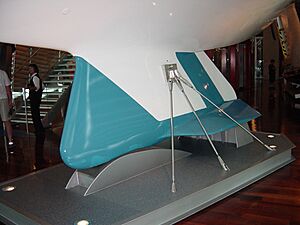
Bond returned in 1983 for his fourth try. He even brought a golden wrench, joking he'd use it to take the Cup home! Seven teams challenged for the Cup that year. They raced in the first Louis Vuitton Cup to decide who would challenge the NYYC. Bond's boat, Australia II, designed by Ben Lexcen and skippered by John Bertrand, easily won the Louis Vuitton Cup. The NYYC chose Dennis Conner in Liberty to defend.
Australia II had a famous Boxing Kangaroo flag and a secret winged keel design. The boat was kept hidden between races. The NYYC even tried to get the boat disqualified. In the Cup races, the Americans started strong. But the Australians came back from being down 3-1 to win the 1983 America's Cup 4-3! This was the first time the NYYC had lost the Cup in 132 years and 26 challenges. It was a huge moment in sports history.
After this, the America's Cup was defended outside the US for the first time, in Fremantle, Australia. Many countries became interested in competing.
Dennis Conner came back in 1987, representing his hometown San Diego Yacht Club. His boat Stars & Stripes 87 won the 1987 Louis Vuitton Cup against 13 other teams. In the America's Cup, he faced the Australian defender Kookaburra III. Stars & Stripes 87 won in four straight races.
Technology was becoming very important. Australia II had its winged keel. The New Zealand boat that Conner beat in the Louis Vuitton Cup was the first 12-metre boat made of fiberglass. There was some discussion about whether the fiberglass hull was fair, but it was found to be within the rules.
The Big Boat Challenge: 1988
In 1987, after Conner won the Cup back, a New Zealand team led by Sir Michael Fay made a surprise challenge. Fay challenged with a giant boat called New Zealand (KZ1), or the Big Boat. It was a 90-foot monohull, the biggest possible under the original Cup rules. The San Diego Yacht Club didn't want this. They wanted to keep racing 12-metre yachts. A legal fight started, and a court ruled that Fay's challenge was valid.
Forced to race quickly, Conner and the SDYC looked for a way to win. They realized that a catamaran wasn't forbidden by the rules. Catamarans are much faster than monohulls of the same length. Conner had a very advanced catamaran built with a wing sail, also named Stars and Stripes.
The two boats raced in September 1988. New Zealand lost by a huge amount. Fay went back to court, saying the race was unfair. A court agreed at first, but then a higher court overturned that decision. So, the SDYC kept the Cup. This was a very controversial Cup match.
New Class of Boats: 1992–2007
After the 1988 controversies, a new boat class was introduced: the International America's Cup Class (IACC). This replaced the 12-metre class.
In 1992, for the first time, the challenger was from a non-English-speaking country, Italy. The Italian boat Il Moro di Venezia won the Louis Vuitton Cup. But it lost 4-1 to the American boat USA-23 from the America³ team.
In 1995, Team New Zealand, skippered by Russell Coutts, won the challenger series with NZL 32, nicknamed "Black Magic" for its speed. Black Magic then easily beat Dennis Conner's Stars & Stripes team 5-0 to win the Cup for New Zealand. During the challenger series, the Australian boat oneAustralia famously sank, but everyone on board was safe.
In 1996, a man damaged the America's Cup with a sledgehammer. The damage was so bad that people thought it couldn't be fixed. But the original makers of the cup, Garrards in London, carefully repaired it for free. In 2003, they added an extra base to the cup to fit more winners' names.
In 2000, in Auckland, Team New Zealand, led by Sir Peter Blake and skippered by Russell Coutts, defended the Cup against the Italian Prada Challenge. This was the first America's Cup where neither the challenger nor the defender was American.
Over time, the rules about where designers and crew had to be from became harder to enforce. Many members of the New Zealand team joined the Swiss Alinghi team for the 2003 challenge. To meet the crew rules, they moved to Switzerland.
In 2003, Ernesto Bertarelli's Alinghi team, representing the Swiss club Société Nautique de Genève (SNG), won the 2003 Louis Vuitton Cup and then the 2003 America's Cup in a 5-0 sweep. This was the first time a European team had won the Cup in 152 years!
For the 2007 challenge, SNG changed the rules. The only nationality rule left was that the boat had to be built in the country of the club. This allowed the 2007 America's Cup to be held in Valencia, Spain. It was the first time the Cup was held in Europe since 1851. Eleven teams from 9 countries challenged. Emirates Team New Zealand won the Louis Vuitton Cup 2007 and then raced Alinghi. Alinghi successfully defended the Cup 5-2.
The Giant Multihulls: 2010
After Société Nautique de Genève successfully defended the trophy in the 32nd America's Cup, they accepted a challenge from a Spanish yacht club. But the rules they set were criticized. The Golden Gate Yacht Club (GGYC) then filed its own challenge and went to court, saying the Spanish club wasn't qualified.
There was a long and difficult legal battle. Finally, in 2009, a court decided that the Spanish club wasn't a valid challenger. This made the GGYC the rightful challenger.
Since the two teams couldn't agree on other rules, the race happened as a special one-on-one match under the original Deed of Gift. No other clubs or teams could join.
The race was held in Valencia, Spain, in February 2010. It featured gigantic, specialized 90-foot multihull yachts. The challenging trimaran USA-17 had a special rigid wing sail that gave it a huge advantage. It won the 2010 America's Cup in two straight races.
Foiling Catamarans: 2013–2017
The challenger for the 34th America's Cup was Club Nautico di Roma from Italy. In September 2010, the GGYC and Club Nautico di Roma announced the rules for the 2013 match. It would use a new class of boat, the AC72, a wing-sailed catamaran. Smaller versions, called AC45s, were used in preliminary races around the world.
In May 2011, Club Nautico di Roma pulled out because they couldn't raise enough money. The Royal Swedish Yacht Club then became the challenger.
In August 2012, Team New Zealand's AC72 boat was seen "flying" on hydrofoils. This started a race to develop better foils. The Royal New Zealand Yacht Squadron easily won the Louis Vuitton Cup against the Italian and Swedish challengers. The final match between the US and New Zealand was the longest ever. The Golden Gate Yacht Club made an amazing comeback, winning eight races in a row to defend the Cup 9-8!
The next America's Cup was held in Bermuda in 2017. Preliminary races were held in different locations using foiling AC45s. After the 2013 America's Cup, the Golden Gate Yacht Club accepted a challenge from the Hamilton Island Yacht Club. They proposed a new, smaller 62-foot wingsail foiling catamaran class. The Hamilton Island Yacht Club pulled out in July 2014 due to unexpected costs.
The challenger committee then took over, making decisions by vote. When an even smaller 50-foot wingsail foiling catamaran class was voted in April 2015, Luna Rossa Challenge also pulled out, saying they had wasted money developing the larger boat. Teams from France, Japan, New Zealand, Sweden, and the UK remained. In June 2016, for the first time, an America's Cup race was held on fresh water in Lake Michigan. Emirates Team New Zealand won the 2017 Louis Vuitton Cup and then challenged Oracle Team USA. New Zealand won the America's Cup with a score of 7 to 1.
The AC75 Monohulls: 2021 America's Cup
The 36th America's Cup was held in Auckland, New Zealand, in March 2021. The challenger series, called the Prada Cup, took place earlier. For this Cup, a new boat design was agreed upon: the "AC75". This was a 75-foot foiling monohull (a single-hulled boat that "flies" on foils). It had common parts for the foils and software.
The challenger was Luna Rossa Prada Pirelli, who won the 2021 Prada Cup. The start of the America's Cup was delayed a few days due to COVID-19 rules in Auckland.
Emirates Team New Zealand, sailing their AC75 boat Te Rehutai, successfully defended the 36th America's Cup in Auckland on March 17, 2021. They beat the Italian challenger Luna Rossa Prada Pirelli by 7 races to 3. Even in light winds, the new AC75 boats reliably "foiled" at speeds over 30 knots. It was a fantastic show for thousands of spectators watching from boats and on land. The races were held close to shore, making it easy for people to watch. Both teams showed great sportsmanship after the competition.
On March 19, 2021, Emirates Team New Zealand confirmed that the Royal New Zealand Yacht Squadron had accepted a challenge for the 37th America's Cup (AC37) from the Royal Yacht Squadron Racing, represented by INEOS TEAM UK. This British team will be the official challenger for AC37.
The Royal New Zealand Yacht Squadron said it was great to have the Royal Yacht Squadron Racing involved again, since they were the club that started the America's Cup over 170 years ago. They look forward to working with them on the next event.
Rules for the 37th America's Cup will be announced later. Here are some key points that have been agreed:
- The AC75 boat class will be used for the next two America's Cup events.
- Teams can only build one new AC75 boat for the next event.
- One group will be in charge of all racing and business activities for AC37.
- Teams are looking for ways to reduce costs to attract more challengers and help new teams.
- A new rule will require 100% of the race crew to be citizens of the country their yacht club is from. There might be an exception for a few non-nationals from "Emerging Nations."
- The location for the next Cup will be chosen within six months, and the race dates will be announced.


